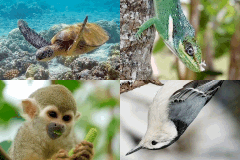AnAge entry for Oryctolagus cuniculus
Classification (HAGRID: 02236)
- Taxonomy
-
Kingdom: Animalia
Phylum: Chordata
Class: Mammalia (Taxon entry)
Order: Lagomorpha
Family: Leporidae
Genus: Oryctolagus
- Species
- Oryctolagus cuniculus
- Common name
- European rabbit
Lifespan, ageing, and relevant traits
- Maximum longevity
- 13 years (captivity)
- Source
- ref. 1306
- Sample size
- Large
- Data quality
- Acceptable
- Observations
Although in the wild females reach full sexual maturity at the age of 2 years, in domesticated animals females can reproduce when they are only three months old. There are many anecdotes concerning the longevity of rabbits. It has been estimated that both in the wild and in captivity they rarely live more than 9 years [0434]. A rabbit in Australia called "Flopsy" reportedly lived 18.8 years in captivity after being caught in the wild [0551], but this record cannot be confirmed. Record longevity in zoos and parks is 13 years based on data retrieved from ZIMS [1306].
Life history traits (averages)
- No information is available on life history. Please contact us if you wish to suggest or contribute data.
Metabolism
- Typical body temperature
- 312ºK or 39.0ºC or 102.2ºF
- Basal metabolic rate
- 7.3950 W
- Body mass
- 2167.9 g
- Metabolic rate per body mass
- 0.003411 W/g
References
- [1136] Gomes et al. (2011), Comparative biology of mammalian telomeres: hypotheses on ancestral states and the roles of telomeres in longevity determination (PubMed)
- [0489] Forsyth et al. (2005), Lagomorphs (rabbits, pikas and hares) do not use telomere-directed replicative aging in vitro (PubMed)
- [0671] Richard Weigl (2005), Longevity of Mammals in Captivity; from the Living Collections of the World
- [0036] Savage et al. (2004), The predominance of quarter-power scaling in biology
- [0420] White and Seymour (2003), Mammalian basal metabolic rate is proportional to body mass2/3 (PubMed)
- [0610] Ernest (2003), Life history characteristics of placental non-volant mammals
- [0189] Kapahi et al. (1999), Positive correlation between mammalian life span and cellular resistance to stress (PubMed)
- [0434] Ronald Nowak (1999), Walker's Mammals of the World
- [0113] Ioannidis et al. (1997), Detrimental effect of aging on the endurance of bone cement. An in vivo and in vitro study in rabbits (PubMed)
- [0114] Adenot et al. (1997), In vivo aging of oocytes influences the behavior of nuclei transferred to enucleated rabbit oocytes (PubMed)
- [0676] Purvis and Harvey (1995), Mammal life-history evolution: a comparative test of Charnov's model
- [0455] Virginia Hayssen et al. (1993), Asdell's Patterns of Mammalian Reproduction: A Compendium of Species-Specific Data
- [0112] Langin et al. (1992), Drop in the "atypical" beta-adrenergic response and modification of the beta/alpha 2-adrenoceptor balance in fat cells from aging rabbits (PubMed)
- [0542] Bernhard Grzimek (1990), Grzimek's Encyclopedia of Mammals
- [0111] Woodruff-Pak (1988), Aging and classical conditioning: parallel studies in rabbits and humans (PubMed)
- [0680] Wootton (1987), The effects of body mass, phylogeny, habitat, and trophic level on mammalian age at first reproduction
- [0110] Lippman (1985), Rapid in vivo quantification and comparison of hydroperoxides and oxidized collagen in aging mice, rabbits and man (PubMed)
- [0731] Zullinger et al. (1984), Fitting sigmoid equations to mammalian growth curves
- [0109] Staatz and Van Horn (1980), The effects of aging and inflammation on corneal endothelial wound healing in rabbits (PubMed)
- [0115] Fox (1980), The rabbit (Oryctolagus cuniculus) and research on aging (PubMed)
- [0116] Banroques et al. (1978), Aging of pyruvate kinase isozymes in rabbit lens (PubMed)
- [0055] Pearce and Brown (1960), Hereditary premature sensescence of the rabbit. I. Chronic form; general features (PubMed)
- [0054] Pearce and Brown (1960), Hereditary premature senescence of the rabbit. II. Acute form; general features (PubMed)
- [1306] Variation in actuarial senescence does not reflect life span variation across mammals (PubMed)
- [0551] Guinness World Records
External Resources
- Integrated Taxonomic Information System
- ITIS 180129
- Animal Diversity Web
- ADW account
- Encyclopaedia of Life
- Search EOL
- NCBI Taxonomy
- Taxonomy ID 9986
- Entrez
- Search all databases
- Ageing Literature
- Search Google Scholar or Search PubMed
- Images
- Google Image search
- Internet
- Search Google

